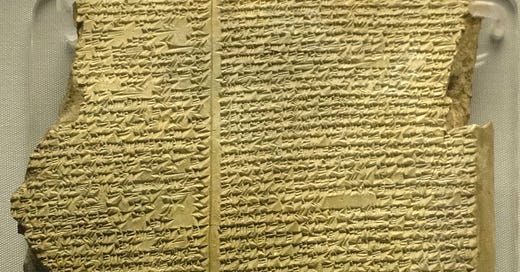The Nineveh Constant: A Forgotten Key to the Bridge Between Cosmos and Quanta
Is the Nineveh Constant an Astronomical Constant of the Universe?
What is the Nineveh Constant?
This value, 195,955,200,000,000, was discovered on cuneiform tablets in the library of King Ashurbanipal in Nineveh (modern-day Iraq). The library is dated to the 7th century BC or later. The French archaeologist Maurice Chatelain, who also worked with NASA, proposed that this number might represent an exact astronomical constant related to the precession of the equinoxes and the dynamics of our solar system, or a "grand cosmic cycle" uniting multiple astronomical and planetary cycles.
243 as a Cosmic Multiplier
Now consider the Platonic Year, the 25,920-year cycle of Earth’s axial precession, which ancient civilisations seemed to encode. Using their 360-day year approximation, the Platonic Year becomes:
Multiplying this by 243:
This result is only 44,789,760,000 seconds short of the Nineveh Constant. But here's the astonishing part:
And 44,789,760,000 is the Euler totient function of the Nineveh Constant:
Euler’s Totient Function, ϕ(n), counts the number of integers less than n that are coprime to it. It’s a cornerstone of modern number theory, also in cryptography, modular systems, and prime structures.
This rare and elegant mathematical equation is a sign of intentional construction:
243 becomes not just a scaling factor but a harmonic divisor connecting the Platonic Year and the arithmetic structure of the Nineveh Constant.
The number 243 holds yet another layer of meaning: it is often cited as the resonant frequency of a bee's buzz. A bee’s wings are oscillating with a frequency of 243 Hz, but the muscles only oscillate at a frequency of 60 Hz. Whether by coincidence or design, this links a humble insect, long associated with sacred geometry and cosmic symbolism, to the Nineveh Constant’s harmonic architecture. In many ancient cultures, bees symbolised divine order, fertility, and prophetic knowledge. Their frequency echoes in the mathematical scaffolding of planetary cycles may hint that the ancients saw the cosmos’ clockwork and its soundtrack.

Another interesting link to 243 in Astronomy. One-tenth of 243 is 24.3. The Earth’s axis of rotation is tilted at an angle of 23.4 degrees away from vertical, perpendicular to the plane of our planet's orbit around the sun. Yes, it’s again intrinsically linked to Earth’s precessional cycle (cosmic time, particularly the Big Year of 25,920 years). 23.4 and 24.3 are permutations of the same digits.
Many scholars have been fascinated by the Nineveh number (nearly 200 trillion) for years. Maurice Chatelain increasingly believes he has found a solution. He says it is no less than the astronomical constant of the universe.
“A clay tablet covered with cuneiform script and discovered in the ruins of Nineveh shows a huge number, 195,955,200,000,000, which represents expressed in seconds, an enormous period of time of 2268 million days or 6.3 million years.
This period of time is an exact multiple of any astronomical cycle known so far and must, therefore, have been an astronomical constant of the universe.”Chatelain, Maurice, Our Cosmic Ancestors, Sedona, Arizona: Temple Golden Publications, 1988. Introduction, p. 5.
According to him, the orbit, in seconds, of every body circling our sun can be evenly divided into the Nineveh number. Chatelain (1988) puts it this way:
“Every period of revolution or conjunction of all the solar system bodies calculated by the Constant of Nineveh corresponded exactly down to several decimal points with the values given in the modern tables of United States astronomers… I have not been able to find even a single period of revolution or conjunction of a solar system planet or satellite that would not be an exact fraction down to the fourth decimal point of the Great Constant of the Solar System.”
Chatelain, Maurice, Our Cosmic Ancestors, Sedona, Arizona: Temple Golden Publications, 1988. Introduction, p. 5.
So, let’s take the example of Halley’s comet to determine the exact time it takes to make one orbit in seconds. We simply divide 195,955,200,000,000 by 84,000 and we get 2,332,800,000 seconds or 38,880,000 minutes or 648,000 hours or 27000 days. As we can notice, all the digits of those numbers add up to 9. The Nineveh Constant appears to encode harmonic cycles based on a 360-day year system, not the modern 365.2422-day Gregorian one, and Halley’s Comet fits perfectly into this system using the ancient model.
Moreover, Chatelain Maurice found that the Nineveh number represents 240 cycles of the “Big Year.” A “Big Year” is the approximately 26,000-year cycle also known as the Precession of the Equinoxes. In my current research, I found it to be 243 cycles, to be exact, if we work in the ancient system of 360 days a year (360 degrees for a full circle). The number 9 is like a numerical reference marker, since 2 + 4 + 3 = 9, and the Nineveh Constant itself (195,955,200,000,000), all the digits add up to 36, so 9.
John Michell supported this work and mentioned :
“In the operations of simple arithmetic and throughout all the numerical manifestations of nature, such as the periods and intervals of the solar system, certain “nodal” numbers occur, providing a link between processes and phenomena which otherwise appear quite unconnected with each other.”
John Michell, Chapter 7: The Canon of Measures.
The bee lives less than 40 days, visits at least 1000 flowers and produces less than a teaspoon of honey. For us, it is only a teaspoon of honey, but for the bee, it is a life. Thank you, bees!






